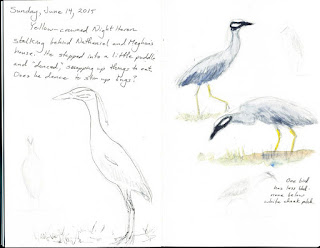In Tampa, Florida last week, I saw three Yellow-crowned Night Herons (one at a time) beside the channel behind my son and daughter-in-law's house. Most of the times I saw them the lighting was very dim (early morning), so I never got a good look at their red eyes, hence the uniform black with no markings for eyes on my sketch. Neither could I see the yellow on their crowns, so I didn't paint it, even though I knew it must be there. I was just sketching what I saw.
The first day I saw a juvenile, with brownish coloring and streaky breast, but didn't have my sketchbook handy, so no sketch of it. Over the next few days I saw two different adults, one with typical markings and one which had less black-- no or almost no black beneath the white cheek. I don't know if that is also typical, but I haven't seen any photos of birds like this.
One morning I was watching the bird with less black while he (she?) was feeding. It stalked slowly on the grass beside the mangroves that border the channel, occasionally jabbing into the grass to grab and eat something. When it got to a puddle, the bird danced in place, repeatedly jabbing into the puddle and grabbing its breakfast.
I loved having several days to observe these birds' behavior as well as to note differences between the two adults. If I were there for longer, I'm sure I would become familiar with the behavior of each bird, each an individual with its own characteristics. It would have been fascinating to watch the young bird grow up, too, and try to determine what behaviors are innate and what are learned.
Click on the image to see it larger












